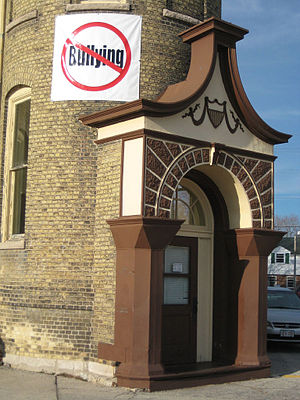 |
| No Bullying sign - School in Racine, Wisconsin (Photo credit: Wikipedia) |
We have interrupted our series on Bullying because a light bulb flicked on. (For the smart alecs out there, yes my light bulb still has an on position!) In Part I, I described the Rowley standard for FAPE. This is the closest thing that we have to a hornbook rule, gold standard in the slippery metaphysical world of special education law.
But as we reported in a previous post, professor Mark Weber has written a law review article that wonders whether the Supremes prematurely decided the issue. Rather than wait for a split among the Circuits and rather than wait for the common law to develop first, the high court jumped in and announced a standard. In a nutshell, the Supreme Court determined in Rowley that FAPE was not a potential maximizing standard. Rather the test was "some educational benefit."
Professor Weber's article also mentions, however, that there are some cases where the Rowley standard is not strictly adhered to. In cases not involving FAPE, like least restrictive environment, FAPE is not in issue and Rowley does not govern. I am summarizing a lengthy academic article here, and as those of you who know me know, that can be dangerous. But two of the other areas he specified where the strict interpretation of Rowley's some benefit test are cases involving inadequate transition services or inadequate behavior interventions. He cites some examples and for me, this notion is an eye opener.
In thinking about the bullying cases, I believe that they may also fit into the grey area concerning the FAPE standard. In particular in TK & SK ex rel LK v. New York City Dept of Educ 779 F.Supp.2d 289, 56 IDELR 228 (E.D.N.Y. 4/25/2011), which is being highlighted in our ongoing series on bullying, the court set a higher bar than Rowley seems to require. There the court ruled that the parents do not need to show that the student was deprived of all educational benefit or that she regressed; rather, the parent only needs to show that her educational benefit was adversely affected by the bullying. Where the bullying reaches a level where the student is substantially restricted in learning opportunities, this court says that FAPE has been denied.
OK so my new theory, inspired by the creative thinking of Professor Weber, is that FAPE is always FAPE, but sometimes it isn't. In particularly hot button cases, like bullying cases, maybe the courts are not applying the strictest version of Rowley. The courts always cite and quote from Rowley, but the application of the standard involves a higher bar for FAPE.
My theory here is based upon the old saw from law school that good facts make good law. So maybe the newer hot button issue cases can have juicer facts. Bullying of kids with disabilities can provide some outrageous facts. So can the restraint/seclusion cases. Is it possible that courts are applying a higher FAPE standard when they are nauseated by the facts of a case? And that these newer hot button issues are pushing the envelope? I know that this one is going to get some reaction. What do you think?
By the way, you really should read Professor Weber's article. The citation is "Common-Law Interpretation of Appropriate Education: The Road Not Taken in Rowley," 41 Journal of Law & Education 95 (January 2012). Also he has provided a link to the internet version of the article on the social science research network: http://ssrn.com/author=83733
Have I stumbled onto something here?







